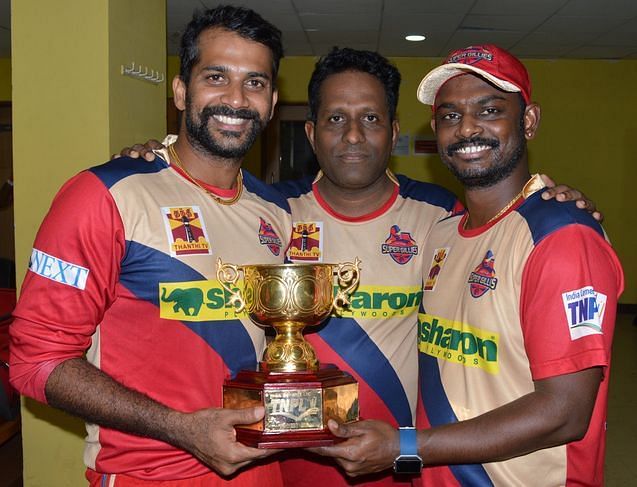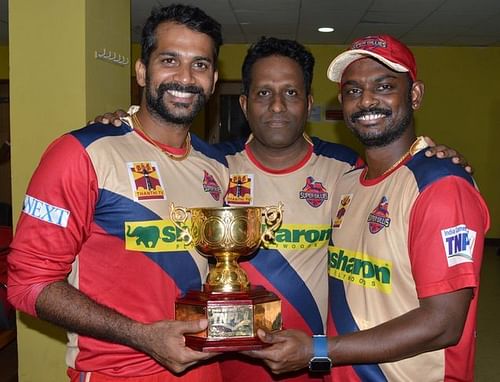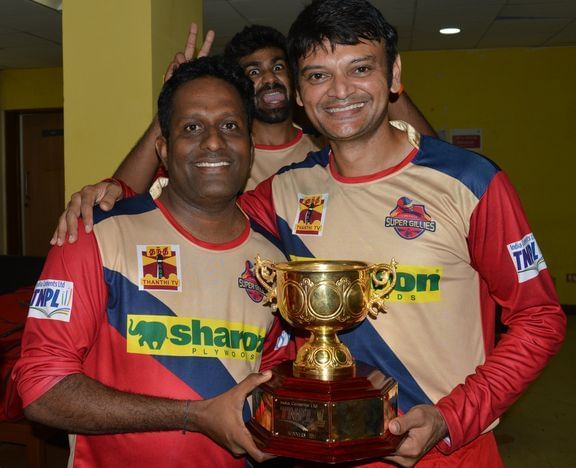
How Lakshmi Narayanan scripted Chepauk Super Gillies' TNPL triumph

2 March 2008. Under the leadership of Virat Kohli, India lifts the U-19 World Cup in Kuala Lumpur. While the spotlight is firmly on Kohli, silently in the shadows, he smiles.
25 April 2010. Chennai Super Kings lift their maiden IPL title at the DY Patil Stadium in Mumbai. He sits silently in the shadows while international stars claim the limelight.
28 May 2011. CSK become the first team to win back-to-back IPL titles, this time at their home ground in Chennai. Again, sitting silently in the shadows, he smiles.
Both times CSK lifted the Champions League T20 (in 2010 and 2014), he was an integral part of the side and yet he sat silenty in the shadows, smiling.
20 August 2017. Chepauk Super Gillies finally end their jinx, beat Albert TuTi Patriots (ending their 13-game winning streak) and claim their first Tamil Nadu Premier League title. And yet again, as history has been created, he sits silently in the shadows.
An integral part of all those title-winning sides, Lakshmi Narayanan, high performance analyst of TNPL 2017 champions Chepauk Super Gillies spoke to Sportskeeda in an exclusive chat about the evolution of the role of an analyst, his time in the IPL with Chennai Super Kings and Gujarat Lions and the challenges and difference between picking a squad for an IPL and a TNPL side.
Cricket hasn't always been the flag bearer when it comes to using technology. Lakshmi Narayanan accepts as much but admits that the game has come a long way since he began as an analyst, more than a decade ago.
"Cricket has changed enormously. Initially, there is not much value for the analyst. Now there is an enormous change. Data is more valued, even the players want to see the videos immediately and want to prepare themselves for the match," he says.
So, has the way in which the data has been presented changed with time? The instantaneous nod of approval says it all. "First we were giving too much raw data. Now the analytics plays a big role as we now give specific data. It is very useful and has become easily understandable in sporting language."
For an outsider looking in, the role of an analyst still seems alien, in this world where almost everything you need is available at the touch of your fingers. And Lakshmi Narayanan explains that his role, while constantly evolving with time, encompasses a lot of different facets.
It is not just about helping out with team selection during an auction but also includes helping individual players work on their strengths and weaknesses and formulate plans for each match, depending on the opposition's strengths and weakness.
Having begun as a video analyst, he is now the high-performance analyst for the reigning TNPL champions. "Initially, it was just videos," he admits. "Now data is supported through videos."
As a mathematics student who also played cricket, he certainly has the inside knowledge on both fronts and demonstrates the role of analytics by talking about a simple plan to dismiss a batsman with a particular weakness.
"For example, if the batsman got out to a right-arm fast bowler, maybe he got out to the bowler because he was bowling 130+ and is comfortable playing someone who bowls 120+. So you have to present the data in the appropriate manner.
"When it comes to Super Gillies' bowlers, they can bowl 130+, some of them can bowl 120+, so we have to decide which bowler is suitable. It is more data-driven as data is supported by videos."
Difference between scouting for TNPL and IPL
While there are plenty of different roles that an analyst performs, arguably the most crucial one is the help provided during the player auction. It certainly must have been difficult to go from having to choose between international stars, for Chennai Super Kings and Gujarat Lions, to picking players from districts that very few would have heard, in the TNPL, especially when all the data you need isn't always available.
Yet Lakshmi Narayanan says that the transition wasn't as difficult because he is used to scouting for players without all the data at his disposal. He adds that the fact that he is from Tamil Nadu and knows the cricketing fraternity in the state was certainly a huge advantage.
Speaking about the lack of data and the strategy for TNPL and IPL, he says: "At the beginning, in 2008 for CSK, not too much data was available. Even for the IPL, domestic data is not available. 50 to 60 % of the data is available for the IPL. For example, domestic players in Ranji Trophy, Vijay Hazare Trophy and Syed Mushtaq Ali Trophy, you have the data. But when it comes to talent scouting, some performances are completely different when it comes to local leagues.
"Not like TNPL, but local leagues, like first division or second division league in Tamil Nadu or something similar in different states. We have identified some of the players. Same thing for TNPL, we have selected players from first division leagues from domestic T20s and there are lots of one-day tournament. Because I am from Chennai, I know most of the cricketers and I follow the matches as well."

For the reigning champions, he spoke about his excellent rapport with coach Hemang Badani as a reason why they were able to pick the right players that they needed.
"Based on the team combination, we then select the players and also Hemang Badani (coach of Chepauk Super Gillies) knows many of the players and my chemistry and rapport with him is good. We know what kind of players will be very easy to choose for our teams."
As time has gone on, he adds that the data that they have gathered has been a huge help and also spoke about the specifics of how an IPL side goes about selecting players for an auction. At the outset, the reason why teams splash the cash on one player might seem outrageous but the devil is in the details and it is role of the analyst to dig those up and ensure that the right combination for the side is achieved.
"Over a period of time, we collected data and analysed the strength and weakness of the player. We also devised player rankings on the basis of the kind of player, whether it is top-order, middle-order or bowler and then selected the player during the auction," he adds.
Again, taking another example, he speaks about the reasoning behind a particular player that a team goes for, in the IPL Auction.
"We identify the players based on the specifications. For example, when it comes to openers, looking at the best combination of foreign and Indian opener. Foreign openers score quickly off the fast bowlers and when it comes to the Indian opener, what is the strike rate against fast bowlers and spinner, so we can balance that. Once the momentum goes, who is the best player for the top order. We have to choose all the combinations from the n numbers of possibilities, when it comes to top-order, middle order and bowlers."
While the possibilities are endless, he is quick to admit that it is a "very tough job". While he does love the auctions because they are interesting, they can be grueling at times too. Yet, no matter, how tough it gets, whether it is at the auction table at next year's IPL or after his side completes another milestone, he will always be there, sitting silently in the shadows.